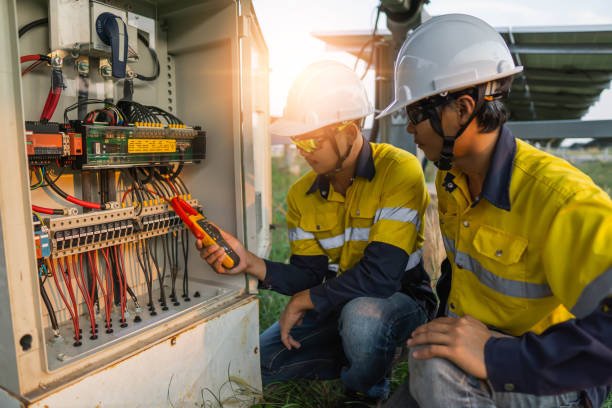When it comes to electrical installation in building construction, precision, expertise, and proper planning are essential from day one. Electrical wiring is one of the core systems of any building, and the quality of its installation directly impacts safety, efficiency, usability, and long-term value. Whether working on residential projects, commercial properties, or multi-unit developments, understanding the full scope of electrical installation helps ensure everything functions smoothly once the building is complete. A well-executed system not only powers the structure but protects occupants and provides room for modern technology and future expansion.
1. Planning, Mapping, and Electrical Blueprinting
Every successful electrical system begins long before a single wire is installed. The planning phase is crucial because it determines how electricity will flow safely and efficiently throughout the building. Electricians collaborate with architects, engineers, and contractors to create detailed blueprints. These include the positioning of outlets, light switches, lighting fixtures, HVAC connections, appliance wiring, panels, and backup power integration.
This stage also involves calculating load demands for each area of the building. Different rooms, such as kitchens, workshops, or offices, require different amperage and dedicated circuits. By addressing load distribution early, electricians prevent future overload problems, tripped breakers, and fire risks.
Forward-thinking planning also means preparing the building for technology upgrades. Many modern buildings require pre-wiring for home automation, smart lighting, high-speed internet, energy-efficient systems, and electric vehicle charging stations. Incorporating these during construction is far easier and more cost-effective than retrofitting later.
2. Understanding Codes, Standards, and Regulations
Electrical codes exist to protect property and human life, which is why compliance is non-negotiable. These regulations specify requirements for grounding, wire sizes, circuit spacing, GFCI and AFCI protection, conduit use, and panel installations.
Licensed electricians are trained to follow these standards and ensure that every aspect of the installation meets both national and local building codes. Inspections occur at various stages of construction to verify compliance and safety. A code-complaint installation lowers fire hazards, prevents equipment failure, and maintains a safe environment for occupants.
Ignoring electrical standards can lead to costly penalties, failed inspections, delays in construction timelines, and in severe cases, legal consequences. For builders and project owners, partnering with qualified professionals ensures the installation is done correctly from the start.
3. Selecting High-Quality Materials and Components
The durability and performance of a building’s electrical system depend heavily on the materials chosen. This includes wires, conduits, breakers, panels, switches, outlets, junction boxes, and protective devices.
Electricians typically use thermoplastic-sheathed cables for most indoor wiring due to their safety and reliability. In areas requiring extra protection—such as basements, commercial facilities, or industrial environments—metal or rigid conduits safeguard wires from moisture, pests, and physical damage.
Breakers and electrical panels must be selected based on load requirements and safety standards. High-quality panels reduce the risk of overheating, short circuits, and electrical fires. Proper grounding equipment is equally critical, ensuring electricity always has a safe path during faults or lightning events.
Choosing premium-grade switches, outlets, and connectors contributes to long-term performance. Cheap materials may initially reduce costs but often lead to failures, repairs, and potential safety hazards later.
4. Safety Practices During Installation
Safety is a top priority throughout the wiring process. Electricians follow guidelines designed to reduce risks, both during construction and once the building is occupied. Some key safety practices include:
-
Proper grounding and bonding of all circuits
-
Balanced load distribution across panels
-
Use of GFCI and AFCI devices in required areas
-
Safe routing of wires to avoid damage
-
Using correct wire gauges for expected loads
-
Clear labeling of circuits, wires, and breaker positions
-
Maintaining dry, clean, and protected working conditions
Lockout-tagout procedures are also used to ensure circuits remain de-energized during installation, preventing accidental electrocution. Each of these practices helps create a safe environment for workers and future occupants.
5. Step-by-Step Installation Process
Electrical installation happens in specific phases:
Rough-In Phase
This includes routing wires, installing boxes for outlets and switches, setting up the main panel, and placing conduits. Nothing is connected yet; the wiring framework is simply put in place.
Mid-Construction Checks
Electricians inspect wiring routes, ensure no cables are pinched or damaged, verify box placements, and coordinate with other trade workers such as plumbers and HVAC teams to avoid future conflicts.
Final Wiring and Connection
After walls are closed, electricians connect fixtures, outlets, switches, and appliances. Panels are energized, breakers installed, and circuits tested.
Testing and Verification
Each circuit undergoes load testing, continuity checks, and insulation resistance tests. This ensures no faults, shorts, or hazards exist before inspectors approve the installation.
This systematic approach guarantees a dependable electrical infrastructure.
6. Integrating Smart and Energy-Efficient Technologies
Modern construction increasingly focuses on energy efficiency and automation. Smart-home wiring, motion-sensor lighting, low-voltage LED systems, programmable thermostats, and integrated security systems have become standard in many new buildings.
Energy-efficient systems lower utility costs, reduce environmental impact, and improve comfort. Buildings that include these features remain more competitive and appealing in the real estate market.
Furthermore, planning for renewable energy sources—such as solar power systems, battery storage, or generators—ensures the electrical design can support modern lifestyle demands.
7. Long-Term Maintenance and System Longevity
Even a perfectly installed electrical system requires ongoing maintenance. Over time, wires may loosen, outlets wear out, and panels may need upgrades. Routine inspections include:
-
Tightening panel connections
-
Checking for overheating or discoloration
-
Testing GFCI and AFCI devices
-
Assessing circuit loads
-
Replacing worn switches or outlets
-
Verifying proper grounding
Early detection prevents costly repairs, power failures, and potential hazards. Well-maintained systems last longer and operate more efficiently.
Conclusion
Electrical installation in building construction requires skill, planning, strict adherence to safety standards, and high-quality workmanship. By focusing on proper design, load management, material selection, safety practices, and long-term maintenance, builders and owners can ensure their electrical systems are reliable, efficient, and ready for evolving modern needs.
At Alpha Omega Electric, we specialize in delivering top-tier electrical installation services for all types of construction projects. Our experienced team ensures every system is safe, durable, and built with precision. Let us power your next project with expertise and commitment you can rely on.
visit: zynrewards


Leave a Reply